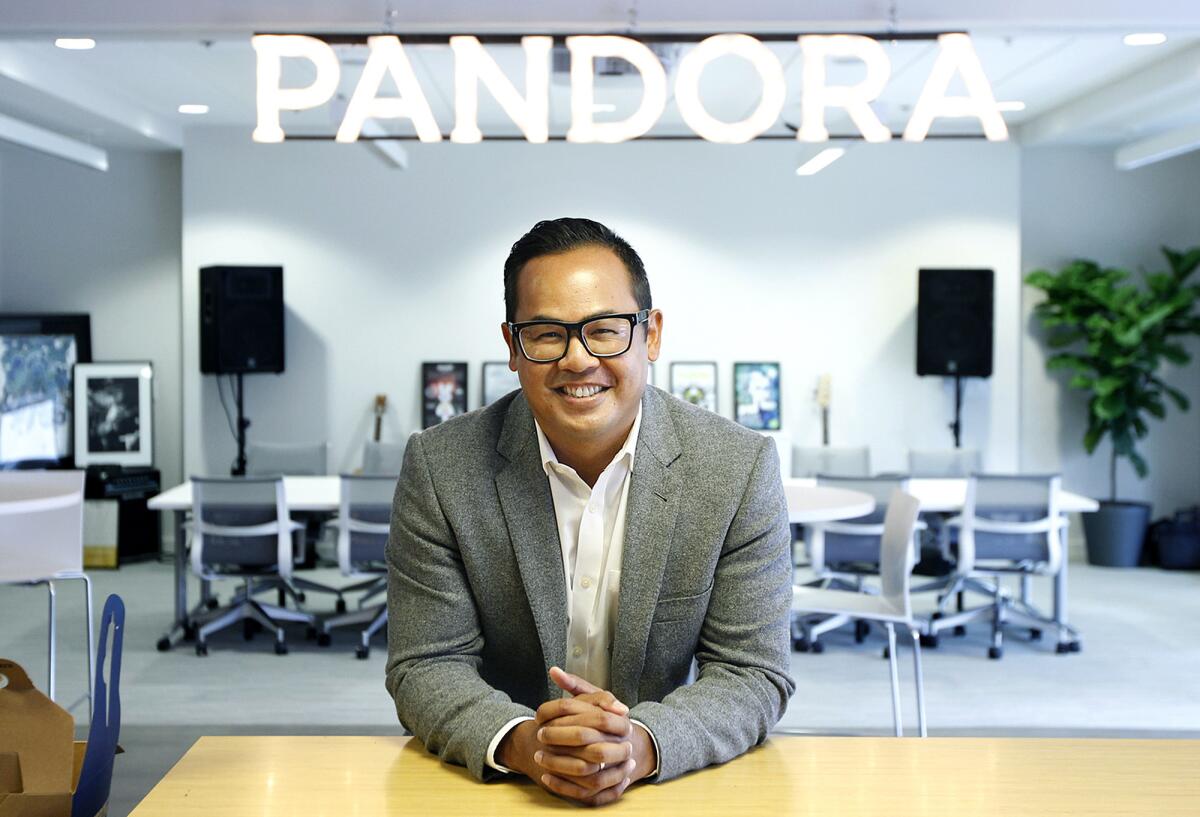Pandora turns up new audience for James Brown biopic

Universal Pictures’ new biopic “Get on Up” about the influential performer James Brown has a clear target audience: fans of the Godfather of Soul.
But the studio ran into the problem of how to broaden the audience and lure younger people with more contemporary music tastes. After all, the most frequent moviegoing demographic was born after the last time Brown hit the top 10 with his 1986 hit “Living in America.” And it has been decades since he released well-known songs such as “Out of Sight,” “Papa’s Got a Brand New Bag” and “I Got You (I Feel Good).”
So Universal got in touch with Pandora, one of the popular music sources for young people. The streaming music service created a station based on the film and used data it collected to find latent James Brown fans.
“We wanted to reach fans of James Brown, but we also knew he had influenced so much music over the years,” said Lindsay Dye, Universal’s director of digital media. “We wanted to reach fans of the Justin Timberlakes and the Janelle Monaes of the world to communicate that message to them and get them out to see the film.”
The service’s “Get on Up” station is essentially a musical ad for the film.
It plays songs by James Brown and similarly funky artists, along with less obvious choices such as the Red Hot Chili Peppers’ “Tell Me Baby,” Run-D.M.C.’s “Is It Live” and Jay-Z’s “Dirt Off Your Shoulder.” Leading up to the film’s opening weekend, the station used animated graphics to explain why certain songs were played and linked to the “Get on Up” Fandango page.
The company took advantage of the wide range of music influenced by the “Please, Please, Please” singer, including the multiple hip-hop artists who have mimicked and sampled beats and riffs from James Brown tracks over the years. The company advertised the “Get on Up” station to people who listened to artists as different from Brown as 2Pac (Tupac Shakur), the Beastie Boys and the Black Eyed Peas.
The “Get on Up” campaign is part of a broader effort by the Oakland company to cater to Hollywood film and TV companies. Studios are looking for more clever ways to market their films to younger audiences who spend more of their time online than watching television or listening to the radio.
Pandora thinks that it has an advantage over traditional advertising because of its young users and vast amount of data. The company said 76 million people listen to its service and used Pandora for a total of 5 billion hours in the three months that ended June 30.
That’s an attractive audience for movie studios that spend a lot of money promoting their films. Pandora has been increasing staffing of sales personnel with expertise in the entertainment industry from places such as Myspace, the video gamer website IGN and Amazon.com. That growth has helped double the number of employees at Pandora’s Santa Monica office, where much of the entertainment team is based, to nearly 100 people in two years.
Pandora’s Internet radio stations run on data. Through its so-called music genome project, the company has analyzed songs using hundreds of characteristics — “prominent organ,” “classic soul qualities,” “a busy horn section” — and uses that information and user feedback to recommend songs and artists.
It also uses the metrics to sell ads that hit specific groups of people.
“Advertisers want to know they’re reaching the right audience at the right time,” said Michael Chuthakieo, who heads Pandora’s entertainment ad sales team. “The shotgun approach isn’t a catch-all anymore.”
What’s unclear is how effective such marketing is when it comes to opening box-office sales. The $30-million “Get on Up,” which stars Chadwick Boseman as Brown, came in third place in its opening weekend in North America behind Marvel’s “Guardians of the Galaxy” and the Scarlett Johansson sci-fi film “Lucy.” “Get on Up” grossed almost $14 million in ticket sales from the U.S. and Canada through Sunday.
Still, this is not the first time that Pandora has worked closely with film and TV studios to get the word out.
Hollywood has tapped the company to assist in promotion for blockbusters including “The Hunger Games: Catching Fire,” along with lower-budget movies such as Sony Pictures’ faith-based drama “Heaven Is for Real.” On the TV side, it helped promote Lionsgate Television’s Netflix prison drama “Orange Is the New Black” by creating “mixtapes” based on what kind of music the characters would listen to.
When the independent Christian film “God’s Not Dead” did surprisingly well at the box office, the filmmakers nodded to ads that were targeted to Pandora listeners interested in religious artists such as the Newsboys, who were featured in the film.
Russ Crupnick, managing partner at research firm MusicWatch, said those potential moviegoers are getting harder and more expensive to reach. He said entertainment firms are smart to partner with a company like Pandora that has a large, youth-driven user base, especially if the film has a musical tie-in.
“Maybe you’ve got a film that’s maybe not a ‘Superman’ or ‘Batman’ and doesn’t have a huge marketing budget,” he said. “What a service like Pandora has is the ability to reach a large audience very effectively.”
Movie ads could represent a big opportunity for Pandora. According to Nielsen, studios spent $3.06 billion advertising films in the U.S. in 2013.
Studios look at Internet radio’s users and see film fans. According to a 2013 Nielsen Cinema Study commissioned by Pandora, people who listen to the service are 28% more likely to see a movie on its crucial opening weekend than those who don’t.
Pandora is touting its ability to target ads as it tries to take a bigger slice of the more than $17-billion U.S. radio advertising market. The company also has spent the last couple of years courting local advertisers, and are looking to pick up political ads as well.
As it gains market share, Pandora is trying to increase its profits. In its most recent quarterly earnings report, Pandora said it expects to generate net income, excluding certain items, of 16 to 19 cents a share for the full year, on revenue of $895 million to $915 million. For 2013, the company reported earnings of 6 cents a share from about $647.5 million in revenue.
Pandora is betting on its advertising model as other streaming music companies try to rake in revenue through subscriptions. Swedish competitor Spotify, San Francisco’s Rdio and Culver City-based Beats Music, recently purchased by Apple Inc., all charge monthly fees for access to their on-demand music libraries.
Also, it could be a while before the next musician biopic gives Pandora an opportunity to create the sequel to its James Brown station. That may have to wait until Don Cheadle’s Miles Davis movie comes around, or until the in-the-works Janis Joplin and Kurt Cobain projects see daylight.
But Chuthakieo said a movie doesn’t need a clear music angle to work for Pandora. “You’re going to see a lot more from us,” he said.
More to Read
From the Oscars to the Emmys.
Get the Envelope newsletter for exclusive awards season coverage, behind-the-scenes stories from the Envelope podcast and columnist Glenn Whipp’s must-read analysis.
You may occasionally receive promotional content from the Los Angeles Times.







